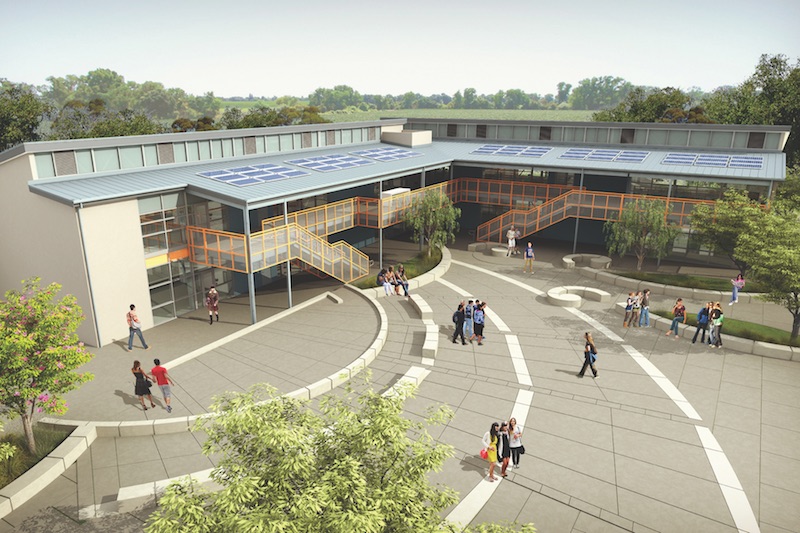The San Carlos (Calif.) School District was in the midst of implementing its master plan when it awarded Quattrocchi Kwok Architects (QKA) and Blach Construction a $30 million contract to build a new 44,000-sf, two-story classroom building at Central Middle School, and remodel the existing building.
That project became the testing ground for Folia, an economical method for school construction that QKA, Blach, and structural engineer Gregory P. Luth and Associates had been working on since 2011.
Building K-12 schools in California poses two problems: it takes forever and it costs a fortune. The San Carlos School District needed to accommodate a student population that’s projected to grow to nearly 4,000 students by 2020, from 3,400 today. Given the high cost of real estate in northern California’s Bay Area, the district chose to optimize its existing properties to address its capacity needs.
Folia, which derives from the Greek word meaning “nest,” provides an alternative to traditional steel-framed classroom construction. Unlike modular construction, the Folia system offers design flexibility for any campus or classroom configuration.
A key to Folia is customized pre-engineering within standardized parameters, says Steve Kwok, a AIA, Partner with QKA. For example, all braced frames are 10 feet wide. The width of the foundation is the same for all school models. Blach produces the building’s braced frames and 10x30-foot exterior steel wall panels in its shop and delivers them to the job site.
Kwok estimates that a Folia school costs about $400 per sf, compared to $500-plus for a traditionally built school. As important, the Building Team took 10 months to complete Central Middle School, which Kwok says is much faster than conventional building methods.
A Folia school is designed to exceed California’s Green Building Code and Energy Code standards. In June, The Division of the State Architect pre-checked a Folia two-story
L-shaped prototype with 12 classrooms. A DSA pre-check shaves months off the design and construction time.
Read about more innovations from BD+C's 2016 Great Solutions Report
Related Stories
75 Top Building Products | Apr 22, 2024
Enter today! BD+C's 75 Top Building Products for 2024
BD+C editors are now accepting submissions for the annual 75 Top Building Products awards. The winners will be featured in the November/December 2024 issue of Building Design+Construction.
AEC Tech | Feb 20, 2024
AI for construction: What kind of tool can artificial intelligence become for AEC teams?
Avoiding the hype and gathering good data are half the battle toward making artificial intelligence tools useful for performing design, operational, and jobsite tasks.
Sustainability | Nov 1, 2023
Researchers create building air leakage detection system using a camera in real time
Researchers at the U.S. Department of Energy’s Oak Ridge National Laboratory have developed a system that uses a camera to detect air leakage from buildings in real time.
Resiliency | Aug 7, 2023
Creative ways cities are seeking to beat urban heat gain
As temperatures in many areas hit record highs this summer, cities around the world are turning to creative solutions to cope with the heat. Here are several creative ways cities are seeking to beat urban heat gain.
AEC Innovators | Jun 15, 2023
Rogers-O'Brien Construction pilots wearables to reduce heat-related injuries on jobsites
Rogers-O'Brien Construction (RO) has launched a pilot program utilizing SafeGuard, a safety-as-a-service platform for real-time health and safety risk assessment. Non-invasive wearables connected to SafeGuard continuously monitor personnel to prevent heat exhaustion on jobsites, reducing the risk of related injuries. RO is the first general contractor to pilot this program.
Office Buildings | May 15, 2023
Sixteen-story office tower will use 40% less energy than an average NYC office building
This month marks the completion of a new 16-story office tower that is being promoted as New York City’s most sustainable office structure. That boast is backed by an innovative HVAC system that features geothermal wells, dedicated outdoor air system (DOAS) units, radiant heating and cooling, and a sophisticated control system to ensure that the elements work optimally together.
Design Innovation Report | Apr 27, 2023
BD+C's 2023 Design Innovation Report
Building Design+Construction’s Design Innovation Report presents projects, spaces, and initiatives—and the AEC professionals behind them—that push the boundaries of building design. This year, we feature four novel projects and one building science innovation.
Design Innovation Report | Apr 19, 2023
Reinforced concrete walls and fins stiffen and shade the National Bank of Kuwait skyscraper
When the National Bank of Kuwait first conceived its new headquarters more than a decade ago, it wanted to make a statement about passive design with a soaring tower that could withstand the extreme heat of Kuwait City, the country’s desert capital.
Design Innovation Report | Apr 19, 2023
HDR uses artificial intelligence tools to help design a vital health clinic in India
Architects from HDR worked pro bono with iKure, a technology-centric healthcare provider, to build a healthcare clinic in rural India.
3D Printing | Apr 11, 2023
University of Michigan’s DART Laboratory unveils Shell Wall—a concrete wall that’s lightweight and freeform 3D printed
The University of Michigan’s DART Laboratory has unveiled a new product called Shell Wall—which the organization describes as the first lightweight, freeform 3D printed and structurally reinforced concrete wall. The innovative product leverages DART Laboratory’s research and development on the use of 3D-printing technology to build structures that require less concrete.

















